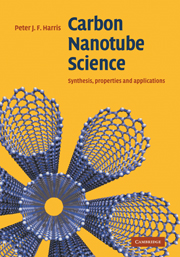Book contents
- Frontmatter
- Contents
- Preface
- 1 Introduction
- 2 Synthesis I: arc- and laser-vaporization, and heat treatment methods
- 3 Synthesis II: catalytic chemical vapour deposition and related methods
- 4 Purification and processing
- 5 Structure
- 6 Physical properties I: electronic
- 7 Physical properties II: mechanical, optical and thermal
- 8 Chemistry and biology of nanotubes
- 9 Carbon nanotube composites
- 10 Filled and heterogeneous nanotubes
- 11 Probes and sensors
- 12 Conclusions
- Name Index
- Subject Index
8 - Chemistry and biology of nanotubes
Published online by Cambridge University Press: 20 May 2010
- Frontmatter
- Contents
- Preface
- 1 Introduction
- 2 Synthesis I: arc- and laser-vaporization, and heat treatment methods
- 3 Synthesis II: catalytic chemical vapour deposition and related methods
- 4 Purification and processing
- 5 Structure
- 6 Physical properties I: electronic
- 7 Physical properties II: mechanical, optical and thermal
- 8 Chemistry and biology of nanotubes
- 9 Carbon nanotube composites
- 10 Filled and heterogeneous nanotubes
- 11 Probes and sensors
- 12 Conclusions
- Name Index
- Subject Index
Summary
The first insights into the chemistry of carbon nanotubes grew out of efforts to open and fill the tubes in the early 1990s. As described in Chapter 10, this work clearly demonstrated one very basic aspect of nanotube chemistry: they are most reactive at the tips. Indeed, the reaction of nanotubes with acids and other reagents could be exquisitely selective, with attack occurring only at defective regions. Since this early work, interest in the functionalization of carbon nanotubes has grown rapidly. In many studies the aim of functionalization has been simply to solubilize the tubes, by attaching hydrophilic species to these normally hydrophobic structures. However, as will be seen, the chemical modification of nanotubes is proving to be valuable in a wide range of areas, from the preparation of carbon nanotube composites to the production of sensors. As well as covalent functionalization, there is great interest in ‘non-covalent functionalization’, i.e. connecting molecules to nanotubes without actually forming chemical bonds. The advantage of this approach is that it avoids disrupting the structure of the tubes, enabling their full properties to be retained. Non-covalent functionalization can be achieved by forming van der Waals bonds between planar groups and the tube walls, or by wrapping molecules helically round the tubes. This chapter begins with an overview of the methods that can be used to chemically functionalize carbon nanotubes. This is followed by a discussion of functionalization with biomolecules. Interest in this area was greatly stimulated by the demonstration that functionalized nanotubes can cross cell membranes, suggesting that tubes could be used to ferry therapeutic agents into cells.
- Type
- Chapter
- Information
- Carbon Nanotube ScienceSynthesis, Properties and Applications, pp. 204 - 226Publisher: Cambridge University PressPrint publication year: 2009



